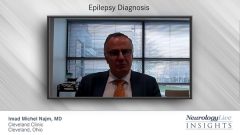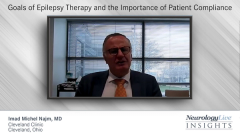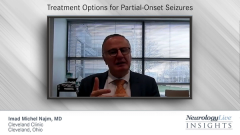
Goals of Epilepsy Therapy and the Importance of Patient Compliance
An overview of the goals of epilepsy treatment, seizure freedom, and the importance of patient compliance.
Imad Michel Najm, MD: The reason we treat patients with epilepsy is to shut down their seizures—in other words, to achieve seizure freedom. We know that we do not have medications that will cure epilepsy; we have medications our patients can take to control these seizures and to keep the person seizure-free. Therefore, when we discuss medication or treatment with a patient, we always make it clear to them that the goal is to completely control the seizures. To control these seizures, the patient needs to take their medications as prescribed—once a day, twice a day, at whatever the doses are prescribed. We always make it clear to patients with new-onset epilepsy—the patient and their families—that treatment of epilepsy does not mean curing epilepsy. Treatment of epilepsy means controlling seizures, and that is our goal.
The most important part of controlling seizures in patients with epilepsy is compliance or adherence to the treatment that was prescribed by the treating physician. It is easier said than done—we cannot just to say that, “It is easy to be compliant with, and to be adherent to, the prescription that the patient was given.” We all know that, as human beings, we are subject to forgetting to do things that we take for granted or that we think of as part of a routine. Life is always unpredictable, and sometimes we are more prone to forget to take a particular medication or a dose of a particular medication. If we look to our patient population and we think about it, what are the possible factors that will make our patients more likely to miss a medication than to take the medication? These factors include, first, whether a patient is having a reaction to a medication. For example, if a patient, every time they take a medication, feels a little sleepy, tired, or slower in their movements, they will be less prone to take the medication. Particularly, this may occur if you tell the patient to take a medication in the morning and evening. They may avoid taking the medication in the morning hours, for example. Effects or adverse effects of medication are important.
The second factor is, how often is the medication dosed? Is it once a day, twice a day, 3 times a day? The more frequent the dosing of the medication per day, the more likely the patient will be missing medications. Therefore, they will be more prone to have seizures. The third factor that plays a role in nonadherence is if the seizures are not controlled. If a patient is taking a medication and they think, “This medication is not helping me,” they may have the misconception that they do not need the medication, or they may be able to miss a dose because they feel like they would be the same. They would be still having seizures and, therefore, avoiding adverse effects and simplifying their own regimen.
In brief, I want to think about what would be the best scenario for a patient not to miss a seizure medication. First, I would try to give my patient medication that requires 1 single daily dose, offer them medication that is well tolerated, and hopefully that gives the patient the best chance of seizure freedom. If we have these 3 factors—we take them into consideration and address them during the process of designing a treatment protocol or a regimen for the patient—the likelihood of missing medication will be much less.
Transcript Edited for Clarity
Newsletter
Keep your finger on the pulse of neurology—subscribe to NeurologyLive for expert interviews, new data, and breakthrough treatment updates.



























